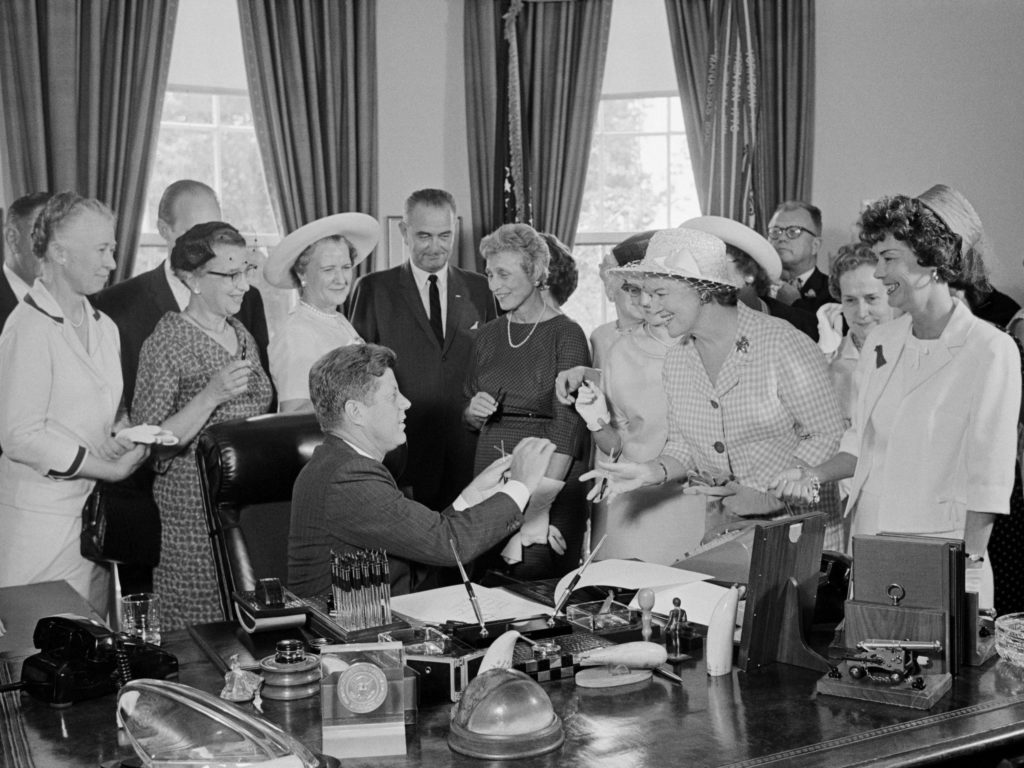This Day in Labor History: June 10, 1963

On June 10, 1963, President John F. Kennedy signed the Equal Pay Act. This was the most important piece of legislation on the long road to pay equality by gender, a goal that we have still not reached.
For the vast majority of American history, women were paid less than men by intention. The only real difference between now, when women are still paid less than men for the same work, and then is that back then there were actual different wage rates by gender. The first legislative attempt to fix this came in 1944, when a Republican congresswoman from New York named Winifred Stanley introduced an equal pay bill. Amazing what happens when you elect women, back then even Republicans. Anyway, of course the men in Congress didn’t take it seriously. Women were routinely paid far less than men. In 1963, women made 59 cents for every dollar a man made on the same job. Other women followed by introducing other acts to address this. In 1945, Mary Norton, a Democrat from New Jersey, tried again. In 1954, Frances Bolton, a Republican from Ohio, did the same. No greater luck in getting men to take it seriously. But slowly, they started chipping away at the indifference of men to the issue of pay inequity. Eisenhower was fairly open to the issue. Opponents said it was impossible to define pay inequity or comparable work. The solution to this was making stronger connections between women and men working the same job, which is how the law has been defined. That concept was created by Katharine St. George, a Republican congresswoman from New York.
The Equal Pay Act’s primary author was Edith Green, a Democrat from Oregon. Kennedy brought greater attention to such issues by creating the President’s Commission on the Status of Women, which was headed by an elderly but still very intellectually active Eleanor Roosevelt. She had always been a major proponent of labor feminism. In fact, this was a major reason why she, Frances Perkins, and other labor feminists so strongly opposed the Equal Rights Amendment for many years–the ERA would erase the idea of needing to protect women on the job. Plus they hated Alice Paul’s right-wing politics. Anyway, at the very first meeting of the Commission, the need for a pay discrimination bill was discussed. Who do you think was the major opponent of the bill? Why, the Chamber of Commerce, of course! The bill should have happened in 1962, but the House and Senate bills were never reconciled and time ran out.
Finally, on June 10, 1963, Congress passed and Kennedy signed the Equal Pay Act, as an addendum to the Fair Labor Standards Act. The act permits unequal pay for men and women if any of the following foundations are used to determine pay: (a) bona fide seniority systems, (b) merit-based pay systems, (c) a pay system that uses quantity or quality of production as a basis for allocating wages, or (d) a system of allocation based on any factor other than sex of the employee. Moreover, the authors of the act were smart enough to anticipate the possible move by employers to lower the wages of men in order to fulfill the requirements of the new law and outlawed that. Women’s wages would have to be raised. In addition, the law made the smart move of avoiding one of the big problems of American labor law, which is setting minimum employee numbers like 50 or 100 for a law to qualify. Here, the minimum requirement was 2, so long as 1 was a woman and 1 was a man. However, what it could not avoid was the same Jim Crow politics that kept labor legislation from covering jobs routinely done by African-Americans. Specifically, it excluded women working in restaurants, hotels, laundries, and hospitals, as well as domestic workers. Sigh.
The Equal Pay Act was soon buttressed by Title VII of the Civil Rights Act of 1964. In fact, the EPA was soon moved to the Equal Employment Opportunity Commission from the Department of Labor to fit the new anti-discriminatory apparatus created in the Great Society.
Of course, the gendered pay gap has by no means reached equity. It has, very slowly, gotten better. Whereas in 1963, women made 59 cents on the male dollar, it is now about 82 cents on the dollar. And while that is progress, given it is 58 years now, I can’t say it is impressive progress. It’s alright. But the power of sexism remains very strong in all of society, very much including the workforce. Similarly, the number of filed complaints under the EPA has slowly dropped. Between 1992 and 2003, the yearly average was about 1,200 claims. Between 2004 and 2014, it fell to about 960 claims. Again, slow but real progress. The bigger piece of progress came in 2009, when Congress passed and President Obama signed the Lilly Ledbetter Act, eliminating the statue of limitations aspect of the Equal Pay Act and giving women greater power to get compensation. Unlike in the 1960s, when many Republicans supported the EPA, the 2009 version of the Republican Party almost unanimously opposed the law because misogyny had become central to its ideology. It remains so today.
There is work to be done still today. We badly need the Paycheck Fairness Act, which would again strengthen the Equal Pay Act, add extra tools to fight discrimination, and outlaw retaliation against workers for discussing their pay. On June 8, 2021, it failed to pass the Senate, with every Democrat voting in favor (minus one who missed the vote) and every Republican voting against it.
This is the 397th post in this series. Previous posts are archived here.


